What Is Video Marketing?
Video marketing is a type of marketing strategy that uses videos to help companies reach, educate and entertain their target audience. It has changed a lot since the first TV commercial was aired in 1941, with the rise in popularity of platforms like YouTube leading to video content having a greater reach than ever.
If A Picture Tells A Thousand Words...
…Then videos let you to tell quite a story. This kind of potential has led to companies using video marketing to do a lot more than the original functions of increasing brand awareness and promoting a product or service. Not only has it evolved into a key way of increasing engagement on social channels, but video marketing is also now an invaluable way of establishing a human connection with your customers.
Four times as many consumers would rather watch a video about a product than read about it.

Why Is Video Marketing Important?
Video is king
Videos have become the number one way people are consuming content online today. In fact, video traffic will make up 82% of all consumer internet traffic by 2022. As of 2017, YouTube alone accounted for over a billion hours of viewing time every day.
Connect with people on their terms
Companies want to connect with their target audience, so it’s clear they need to make videos too. And they are. While blogging was the most important source of content for marketing teams a decade ago, now it’s video. The bottom line: If your marketing team isn’t investing in video and using it regularly to communicate and share ideas with prospective customers, you’re missing out.
It’s authentic
Many consumers now prefer video over other types of media, and one reason for this preference is video’s authenticity. While other types of media are easy to automate, with video there’s always a real person in front of the camera. There’s no hiding. As a marketer, you have to be real.
The Benefits of Video Marketing
Create a sense of trustworthiness and legitimacy
Watching a video is not the same as having a face-to-face chat, but it’s the next closest thing to it. By giving visitors the chance to put a face to your brand, videos are the best way to humanize your company. They allow you to quickly establish a rapport with prospects, which is instrumental in building trust and credibility.

Improve your ROI
Producing videos used to be viewed by some as an expensive marketing strategy that required specialist equipment and expertise. With the rise in popularity of real, unvarnished video marketing, this is no longer the case. And increased accessibility has led to an increase in ROI.
88% of marketers in 2018 were satisfied with the ROI of their video marketing efforts on social media. 52% of marketing professionals also named video as the type of content that produced the best ROI.
Higher engagement rates
Your customers and prospects, as well as people everywhere, are actively searching for ways of making human connections. By interacting with your visitors in a personal manner through video, you are increasing the chances of them making a connection with you and engaging with your brand.
The correlation is highlighted in a 2018 survey carried out by Brightcove, which determined 53% of consumers engaged with a brand after watching one of their videos on social media. The figure rose to 66% when millennials were singled out.
Boost social shares
Posting great video content leads to more social shares, which is a big deal. As a matter of fact, videos are shared 12 times more than links and text posts combined. When somebody shares your post, it demonstrates that a person believed in your content so much they made it a part of their own story.
Increase conversions and sales
Including a video on your company’s landing page has been shown to increase conversion rates by 80%. No matter if you’re creating an introductory video about your brand or a visual demonstration of a new product, your visitors are more likely to listen and ultimately become customers if you share video content.
Be rewarded by search engines
Creating awesome video content will give you twice the opportunity to rank highly on search engines. Firstly, there’s Google. Optimizing your videos around some of Google’s popular video keywords is a great way of maximizing your SEO output.
An even more effective way of increasing video traffic is through the world’s second largest search engine: YouTube. By creating videos that are keyword optimized and meet some of YouTube’s key metrics, you can attract visitors that would never have found you otherwise.
Make your email marketing campaigns more effective
We’re all bombarded with emails on a daily basis. So they need to stand out if they’re to avoid going straight into the trash. Including a video is a great way of doing this. So effective, in fact, that it leads to a 2-3X increase in click-through rates.

Appeal to mobile users
People love to watch videos on the go, which is one reason why videos and cell phones go hand in hand. In fact, more than 70% of viewing time on YouTube comes from mobile devices.
By 2022, analysts predicts that video will be the source of 82% of all consumer traffic on the internet.
Types of Marketing Videos
Now you know why you should be interested in video marketing, it’s time to fill you in on some of the most useful types of videos that your company can start producing.
Brand videos
Perfect for introducing prospects to your vision and core values, brand videos allow you to tell the story of your company in a visual way that can be fun, punchy and full of character.
How-to videos
How-to videos help to build trust with your target audience by displaying your expertise on a topic they might want to know about. They also allow you to enlighten visitors on your business, product or service.
Live videos
One big video trend of 2019 is a preference for content that feels more genuine and authentic. Live videos, by nature, are both of these things. They can be shot on your phone with minimal hassle and are great for providing viewers with an intimate look behind the scenes at your company.
Demo videos
Demo videos allow you to show off a new product or service. A well-made demo video can explain the value of your offering, highlight how it solves a problem and persuade viewers they can’t live without it.

Personalized videos
Creating video content that is customized and relevant to your target audience is becoming an increasingly popular way of forging human connections. Making a prospect feel personally valued can help to turn them into a paying customer.

Customer testimonials
Customer testimonials build trust and credibility by letting your company’s loyal customers showcase your products or services. They offer your visitors a human story they can relate to and a real person they can connect with.
Animated videos
With a little help from some software, your company can make animated videos that explain complicated topics with the aid of imaginative visuals. Making use of quirky characters, vibrant colors and pop-up text, you can create catchy videos that are both lighthearted and memorable.
Expert interviews
Expert interviews build trust and share great ideas with your audience with the help of industry insiders and influencers. Teaming up with influencers is also a sure-fire way of appealing to Gen Z’ers. According to the Digital Marketing Institute, around 70% of teens trust influencers more than traditional celebrities.
Video Marketing Best Practices
Turn on your webcam
Gong recently analyzed the audio and video of more than 100,000 sales meetings to understand the effect using a webcam has on closing deals. When comparing meetings that resulted in successful, closed/won deals to meetings that resulted in unsuccessful, closed/lost deals, they made a remarkable discovery: For the closed/won deals, webcams were used 41% more frequently throughout the sales cycle.
The implication is that keeping your webcam turned on for longer and spending more time communicating via video conferencing will increase your odds of closing a deal. But the research offers even more detailed advice than that. The top sales reps do more than just keep their webcams turned on — they spend more time showing their actual faces, as opposed to showing a presentation or product demo.
As Gong.io’s Chris Orlob said:
Plan your video
Being clear about the purpose of the video, your target audience and the platform you’re going to share it on will help to speed up production time. It can still come across as natural and casual, but it’s important that everything has been carefully thought through before you start recording.
Don’t overcomplicate it
Be short. Be simple. Adding music or any other creative flourishes goes against making sales video as human as possible. Keep it unedited.
Understand your camera
Whether you’re using your phone or a professional camera, get familiar with your kit before you start shooting. If you decide that your camera phone is the way to go, just remember to turn your notifications off so they don’t interrupt.
Don’t close with a hard ask
Instead, increase the click-through rate of your videos by pointing prospects to your site or providing them with a quick avenue to start a conversation with you.
Don’t attempt to control your surroundings
Be you. Be real. Be human. Record where you are, when you think of it. This goes for many marketing videos as well. Our VP of Marketing, Dave Gerhardt, gets 100,000+ views on every LinkedIn video he posts by sticking to these rules. Learn how he does it here.
Record personalized videos for leads
Sales reps aren’t always available to chat with all of their leads via live video at a moment’s notice. But that doesn’t mean, as a rep, that you can’t show your face and make your presence known by sending short, personalized videos to the leads you’re most interested in talking to. Even if your leads live in a different hemisphere, you can make a connection that feels human and personal and address issues and challenges that are specific to them.
Remember, don’t send the same video to a handful of different prospects! As their name suggests, these types of videos should always be personal. So make each one you send about the prospect – their situation, their pain points,
their context.
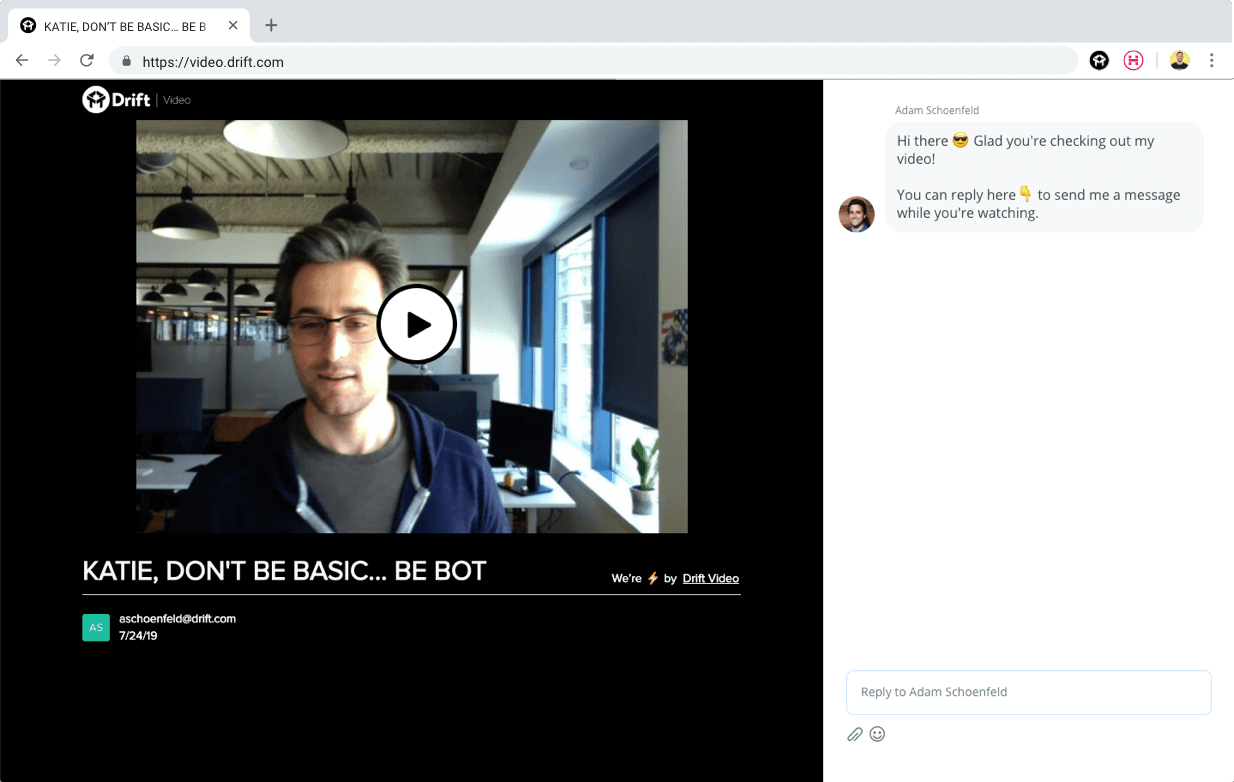
Don’t aim for the perfect pitch
The point again is to be as human as possible. And for most of us, that’s not with a perfectly polished pitch. Being human builds trust.
Include videos in your sales emails
A recent study that looked at 290 of the most successful cold sales emails found that just 13% included multimedia of any kind, and only 6% included video.
Clearly, we’re still in the early days of including video in sales emails. But when you consider that emails containing video have been shown to receive 4x higher click-through rates, there’s a lot of opportunity for you to gain a competitive advantage by using it.
Where Should You Publish Your Video?
Your website
In addition to your social channels, all of your videos should have a home on your website. Having a dedicated news or blog page could be a great place to post regular videos and keep your visitors updated with content they’re more likely to engage with. Adding video to your website will also greatly assist your SEO efforts.
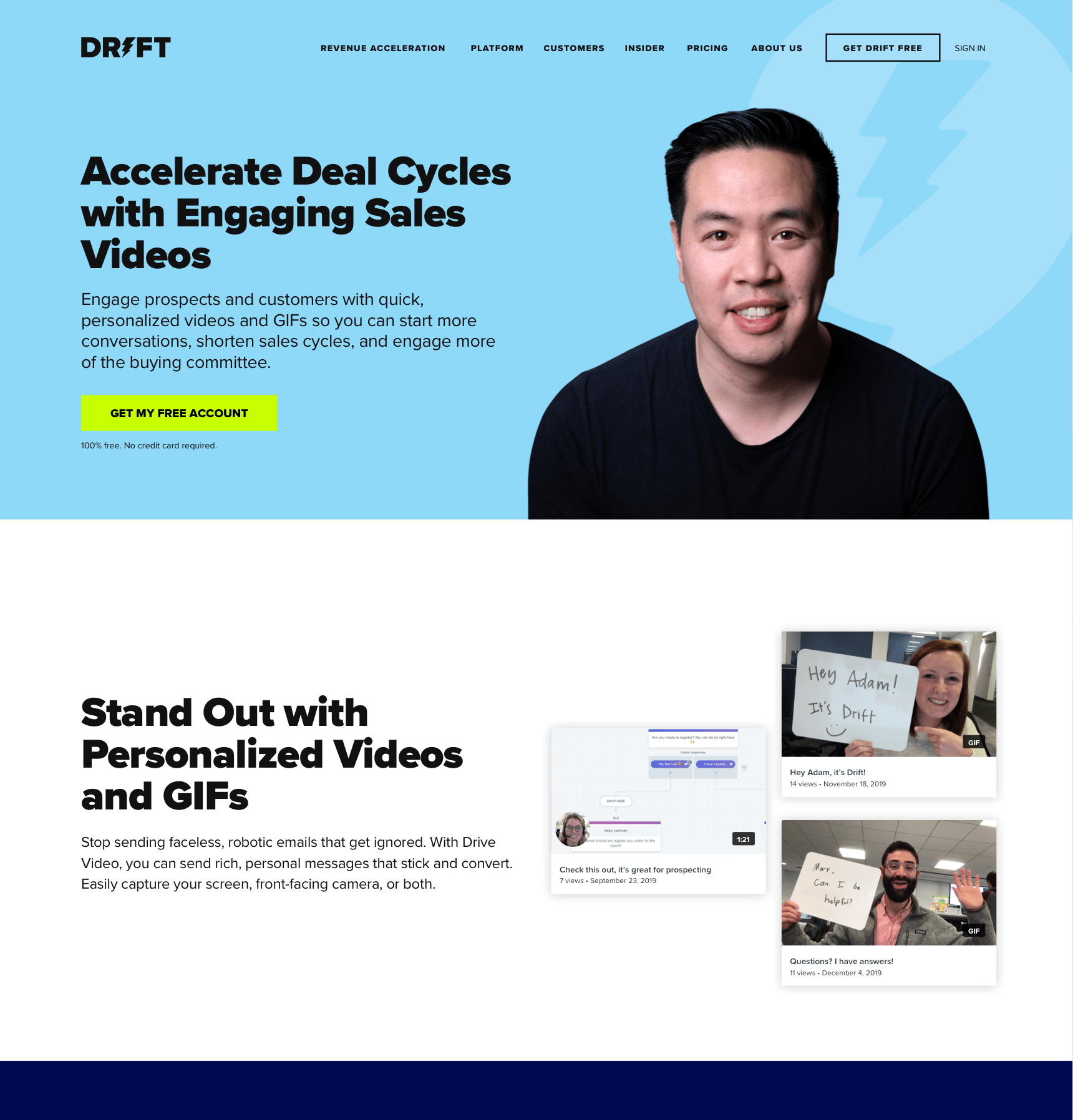
Posting videos on Facebook will keep your followers engaged and help you in reaching out to new ones. Using Facebook Live is also an effective way of sharing content that feels authentic and honest. Even the biggest of corporations can feel more real and down-to-earth by sharing live videos.
YouTube
YouTube is the second largest search engine and receives more than 1.5 billion users per month. Rather than somewhere to post the odd video, YouTube should be used as a platform to share videos regularly. This will help you to build a dedicated audience of subscribers.
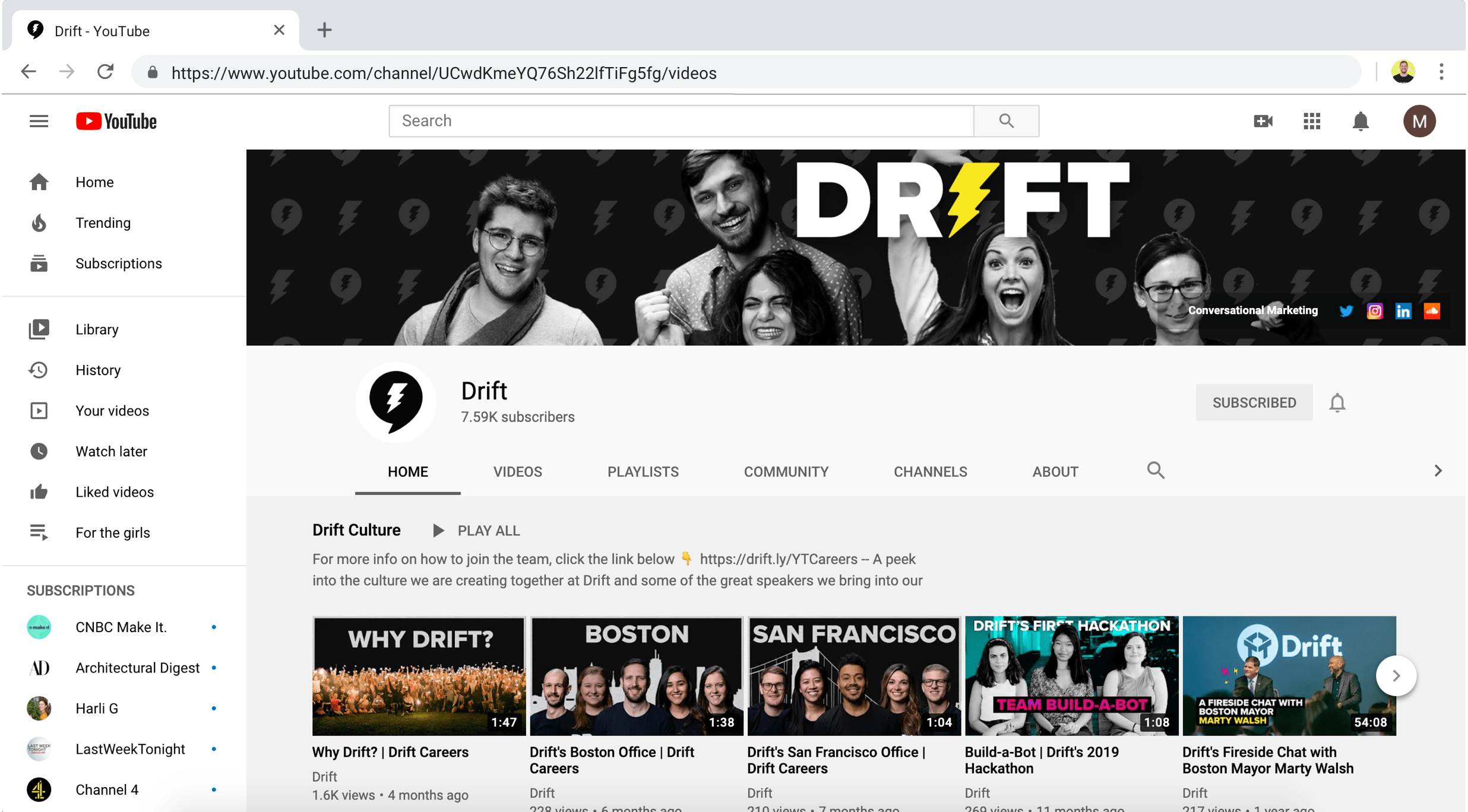
Instagram Stories can only be viewed for one day, so their transient nature can make them feel more relaxed. Sharing real-time videos on Instagram Live is another great way of building trust with your followers.
Incorporating video into Instagram Story ads has been a growing trend for 2019. J&CO Jewellery’s three-day series of Instagram Stories directly led to 58% of their total sales being made during that period.
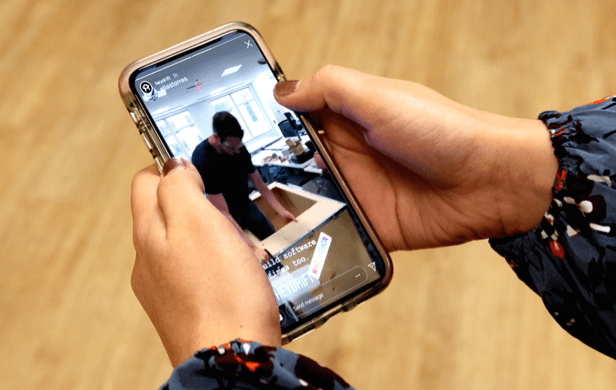
Sharing B2B video content with your professional network is now more rewarding than ever and something that’s almost expected of an active LinkedIn profile.
A LinkedIn guru is Drift’s very own VP of Marketing, Dave Gerhardt. Check out this episode of Dave’s Swipe File podcast to find out why it’s so important to be yourself (yes, really) on LinkedIn. ?
Editing videos into short GIFs and memes on Twitter can help you to attract new followers, especially if they are shared alongside popular hashtags. Tweets that include a video attract 10 times as much engagement than those without.
Of course, Twitter can also be used to share other types of video content too.
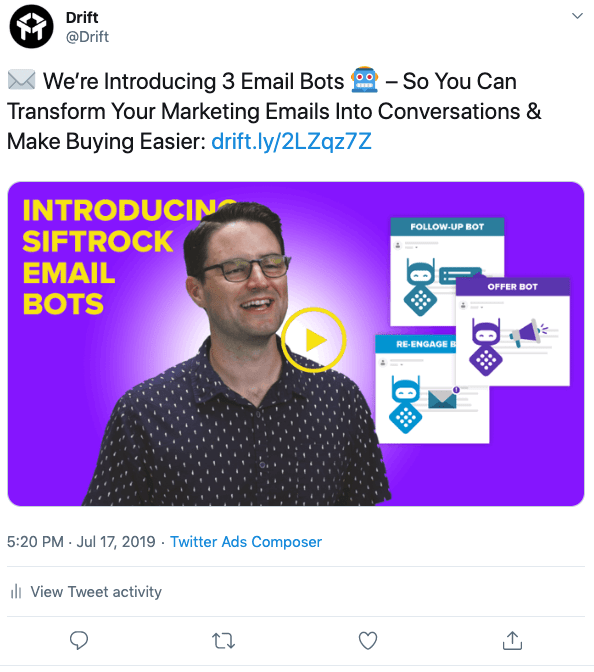
Snapchat
With each snap disappearing in 24 hours, videos are personal and help to forge a strong connection between brands and followers.
Snapchat is often thought of as being one of the more lighthearted social channels, but WWF’s #LastSelfie campaign shows that snaps can convey serious messages too.
Still one of the best ways of getting content to people who know your brand and are interested in it. Simply by including the word “video” in your subject line, you’re looking at an increase in open rates of around 19%.
55% of communication consists of body language. So when we’re using video, we’re better able to connect with our prospects and buyers.
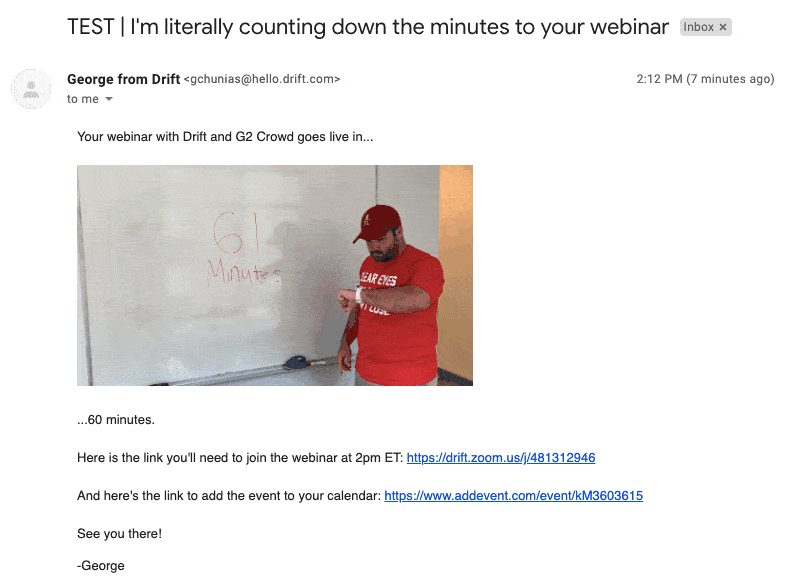
Drift Video
Drift Video is the first video software product designed to start conversations. Here’s some info:
- 75% of B2B software purchases today involve limited interaction with individual salespeople. Drift Video helps you to start conversations again by building trust through personal connections.
- Receive notifications in real-time while someone is watching your video. All you have to do is hop in and say hello.
- Easy to record and share videos that start conversations in just three clicks.
- Built with clear privacy permissions so you can control exactly who sees your videos.
3 Ways to Use Drift Video for Sales Prospecting
1. The Attention Grabber
Instead of introducing yourself with a standard cold email, find something your prospect cares about and connect on that. Share a video that grabs their attention early on to help meet your goal of scheduling a meeting. The point here is to create credibility. Lead with how you’ll help them.
2. The Ego Trap
Do your research. Check out a prospect’s LinkedIn and social accounts. Google their company and name. Find some things you can “pat them on the back” with. Bring up some of the things they recently shared and why they’re interesting and relevant to how you could help them.
3. Recent News
Recent news makes for a great reason to reach out. So again, do your research. Find something about the company in the news – that could be organizational changes, funding, or even a great blog post they just published. Congratulate them and make it all about them. They’ll appreciate the extra effort and research you put into the outreach.
Video Marketing Strategy
Measuring video performance
As well as good old-fashioned view count, you can use metrics such as play rate, social sharing and comments, click-through rates and conversion rates to monitor the performance of your videos. Depending on the goals you have for each video, you will want to use different metrics to determine how successfully they’re performing.
Use data
Analytics tools let you look at the engagement of all the videos you have published across multiple platforms. This can help you understand where viewers are dropping off and how it differs for each platform. Knowing what viewers care about – and more importantly what they don’t – will make sure that every resource you invest in video provides a return in the form of engaged viewers.
Branding your YouTube channel
This ties together your channels and brings a consistent experience to your viewers and subscribers. Many features for branding your YouTube channel are free and should be taken full advantage of. Customizing the background of your channel, showcasing your other social networks and creating a custom header are just a few of the many ways to brand your presence on YouTube.

Think qualitatively
As well as using hard numbers to measure ROI, you should consider qualitative factors such as brand influence, product education and trust in your business.
Narrowcasting
Narrowcasting is the practice of tailoring your marketing materials to specific buying personas. This helps your message to be clearly understood since you can speak in specific industry terminology and go into depth on use cases or details only your target would understand. In turn, narrowcasting helps pre-qualify leads. Anyone that doesn’t find your content of value, or even doesn’t understand what you’re talking about, probably wasn’t a good lead to send to sales anyway.
Ready to learn more about using video in your marketing funnel?
Our webinar 5 Ways to Use Video in Email will show you just how.
5 Ways to Use Video in Email
Ready for higher email engagement? Watch this video to learn 5 secrets to boost your engagement rates today.
